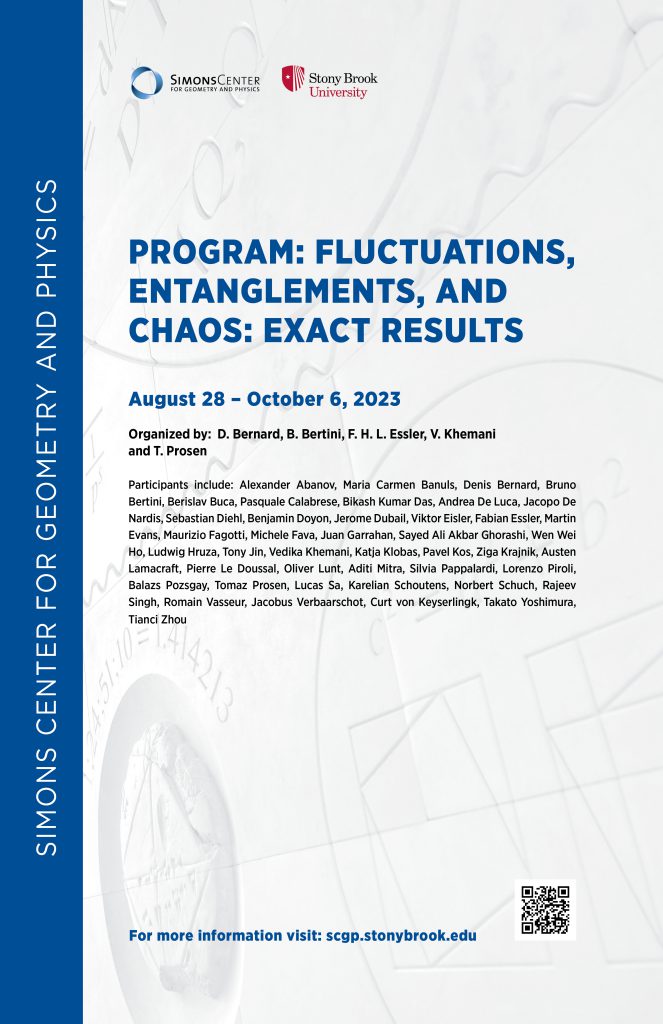Organized by: D. Bernard, B. Bertini, F. H. L. Essler, V. Khemani and T. Prosen
Experimental advances in ultra-cold atomic physics and building quantum simulators have opened up new research areas in quantum many-body physics focused on inherently dynamical properties. Examples of fundamental questions that have been investigated in the last few years included characterizing quantum many-body chaos, describing the spreading of quantum information, defining and classifying novel “dynamical phases” in periodically driven and/or open systems and understanding the effects of quantum noise. Investigating these questions is intrinsically difficult as they pertain to non-equilibrium properties of interacting many-particle quantum systems. Remarkable progress had been achieved by considering simplified models for quantum dynamics, so-called quantum circuits (QC). These retain the key property of spatial locality, but consider discrete time evolution based on sequences of simple quantum gates. These setups can be equivalently thought of as continuous in time but subject to a periodic driving.
QC allow the analysis of both unitary and non-unitary discrete time evolution, which describes noisy or monitored systems. The latter is of particular interest in relation to the technologically-driven recent emergence of noisy, intermediate-scale quantum devices
(NISQ). These exhibit environmental noise and decoherence and also allow partial quantum measurements during the dynamics (a key capability for error correction in future “fault-tolerant” quantum computers). QC are particular classes of tensor networks, which have revolutionized our understanding of the role of quantum entanglement in many-particle quantum systems and are the numerical method of choice for investigating quantum dynamics in low dimensions. One objective of studying quantum circuits has been to understand how to modify existing tensor network methods in order to overcome the so-called entanglement barrier in non-equilibrium dynamics.
A separate but closely related line of research has focused on formulating and solving paradigmatic models for stochastic continuous-time dynamics in extended systems. Here a key objective is to develop a quantum analogue of the celebrated macroscopic fluctuation
theory, which provides an effective description of transport and fluctuations in classical stochastic systems. A key stepping stone in this classical context was the formulation of exactly solvable models such as simple exclusion processes. Very recently quantum
versions of these processes have been formulated and it was shown that the noise-averaged dynamics is described by Lindblad equations that can be mapped to unusual kinds of quantum integrable models. Interestingly, in particular limits and settings these models reduce to the extensively studied classical exclusion processes.
Our aim is to bring together scientists who have been at the forefronts of recent developments in quantum circuits, stochastic quantum dynamics, tensor networks and solvable classical stochastic processes and provide a platform for cross-fertilization between these
currently only loosely connected communities. The Program will focus on two closely connected thematic centers of gravity : (i) exact results on open, stochastic, out-of-equilibrium systems and (ii) exact results on quantum circuits, chaotic or integrable.
This program will also be hosting a workshop: Fluctuations, Entanglements, and Chaos: Exact Results: August 28, 2023- September 1, 2023
Schedule of Program Talks:
| DATE and TIME | TITLE | SPEAKER | ABSTRACT |
|---|---|---|---|
| Tuesday 9/5 at 10:30am | Rise and fall of critical correlations after measurements |
Sara Murciano
|
Abstract |
| Wednesday 9/6 at 10:30am | Hierarchical generalization of dual unitarity |
Pavel Kos
|
Abstract |
| Thursday 9/7 at 10:30am | Temporal Entanglement in Chaotic Quantum Circuits |
Bruno Bertini
|
Abstract |
| Friday 9/8 at 10:30am | Non-equilibrium O(N) models: Critical exceptional points, Goldstone limit cycles, and new non-equilibrium universality | Sebastian Diehl | Abstract |
| Monday 9/11 at 10:30am | Converting entanglement into mixture: a new algorithm for long-time dynamics with tensor networks | Mari Carmen Bañuls | Abstract |
| Tuesday 9/12 at 10:30am | Quantum jamming brings quantum mechanics to macroscopic scales | Maurizio Fagotti | Abstract |
| Wednesday 9/13 at 10:30am | Symmetry Classification of Lindbladians and PT-symmetric Hamiltonians | Lucas Sa | Abstract |
| Thursday 9/14 at 10:30am | TBA | Cheryne Jonay | |
| Friday 9/15 at 10:30am | Statistics of matrix elements in integrable models | Fabian Essler | Abstract |
| Monday 9/18 at 10:30am | Operator dynamics in Floquet many-body systems | T. Yoshimura | Abstract |
| Wednesday 9/20 at 10:30am | Can the macroscopic fluctuation theory be quantized? An introduction to QSSEP | L. Hruza | Abstract |
| Thursday 9/21 at 10:30am | Chaos and Relaxation in a Dissipative Sachdev-Ye-Kitaev Model | Jacobus J. Verbaarschot | Abstract |
| Friday 9/22 at 10:30am | Playing with free probability in noisy many-body systems | Denis Bernard | Abstract |
| Monday 9/25 at 10:30am | Space-time dual cat and clock models | Austen Lamacraft | Abstract |
| Tuesday 9/26 at 10:30am | Statistical mechanics insights into the complexity of tensor networks contractions | Romain Vasseur | Abstract |
| Wednesday 9/27 at 10:30am | Floquet spin chains: Strong Modes, Almost Strong Modes, and Topological Defects | Aditi Mitra | Abstract |
| Thursday 9/28 at 10:30am | Counting statistics of fermions (interacting and non-interacting) and the Gaussian free field | Pierre Le Doussal | Abstract |
| Friday 9/29 at 10:30am | Integrable Digital Quantum Simulation: Generalized Gibbs Ensembles and Trotter Transitions | Lorenzo Piroli | Abstract |
| Monday 10/2 at 10:30am | Correlation functions in GGEs: from the XX chain to the sine-Gordon model | Benjamin Doyon | Abstract |
| Tuesday 10/3 at 10:30am | Nonlinear sigma model description of monitored free Majorana fermions | Michele Fava | Abstract |
| Wednesday 10/4 at 10:30am | Entanglement Hamiltonians in quantum many-body systems | Viktor Eisler | Abstract |
| Thursday 10/5 at 10:30am | Eigenoperator thermalization theory | Berislav Buca | Abstract |


